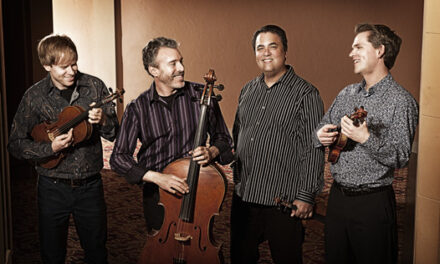The concept of The Oper& (Operand) derives from the variation of text as it relates to performance and to the experience of the “show” that its cast and viewers have every night. Spontaneously and without guidance from onstage or backstage, a network of computers helps create the range of elements we experience throughout the 90 minutes. Text, lights, and video are all chosen in random order, affecting the staging prepared by the quick, expertly prepared Lorelei Ensemble on stage at the Rubenstein Arts Center.
Four versions of the system were produced throughout the evening. Each generated video images, soundscapes, and algorithm-determined sentences (read aloud by the ensemble) as well as voice-over narration. As the system created each of the four new worlds, marked by footage of civilization and natural disasters, a glitch in the system caused each to implode and begin again.
The idea of Chance incorporated into art is not a revelatory one. Artists such as John Cage and Merce Cunningham relied on the organic emergence of chance in their work, often emerging from a system or vocabulary set in place by the artists themselves. Here, artists/creators Jim Findlay, John Supko, and Bill Seaman programmed the systems into a machine that was unaware chance was occurring. The thrill of the evening came in watching the art which emerged from the performers who were prepared for whatever the computer threw at them and the art that the computer created from its vocabulary.
As a work of musical composition, Supko and Seaman’s vocal writing is challenging, reminiscent of Philip Glass’ Einstein on the Beach for its challenging counterpoint. The music, like the system, feels a bit formulaic, predictable even, each climax emerging from merely revving up the tempo to form a resolution where a cadence would sometimes be.
This is not to say that the writing of the work is not impressive. Try writing music in an experiment in which you do not know what is going to be said or what comes next. Calling this event an “opera” or even “song cycle” is a bit forced, as there does not seem to be much of a plot or through line. What we can ascertain from the footage of rubbled skyscrapers, hurricanes, and civilization (designed by Bill Seaman and Keith Skretch) is the metaphor of man vs. nature à la Koyaanisquatsi.
Indeed The Opera& is a major achievement in observing the lengths to which the creators have manipulated technology to influence performance. Do not go expecting a cohesive opera; rather, experience the experiment for its inventive methodologies. This is a piece that presents a fascinating idea, one that could, perhaps very soon in the future, be utilized in the creation of a whole new form of narrative opera. Before that happens, it’s best to see how it’s done, and these persentations provide the opportunity. It’s not for everyone to enjoy, but should be appreciated by all.
See the sidebar for details on upcoming performances.











